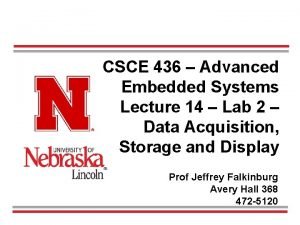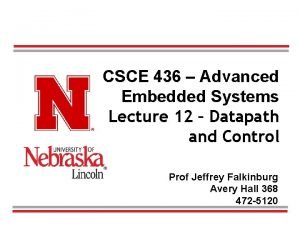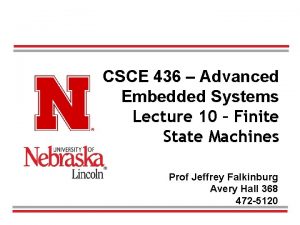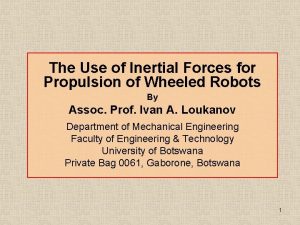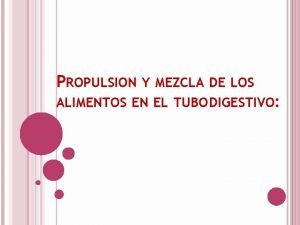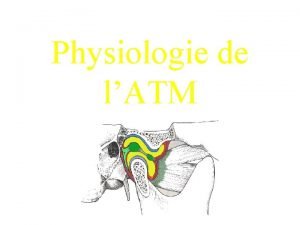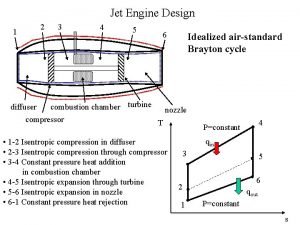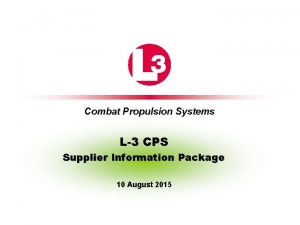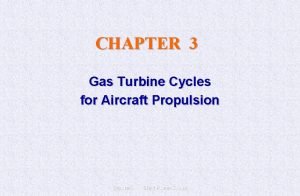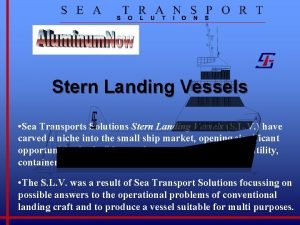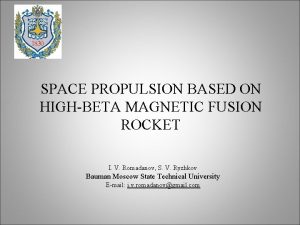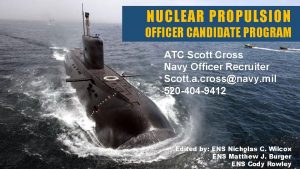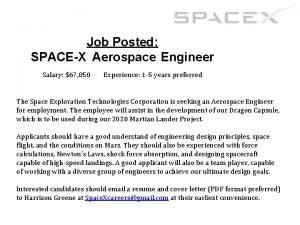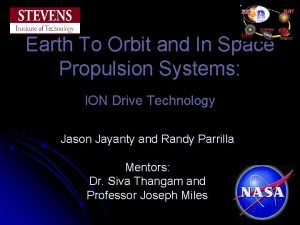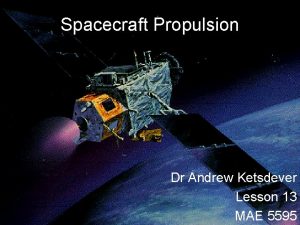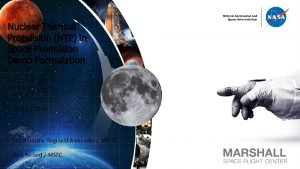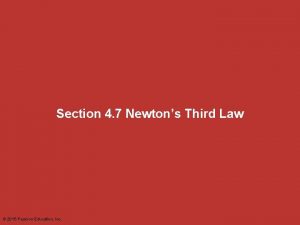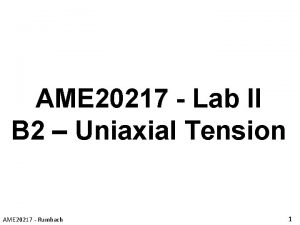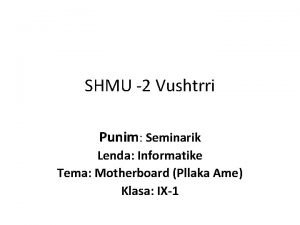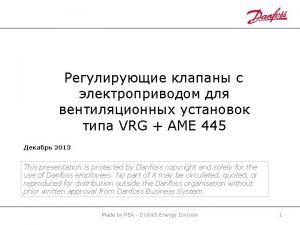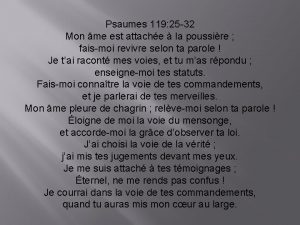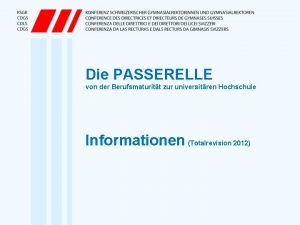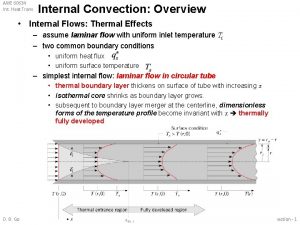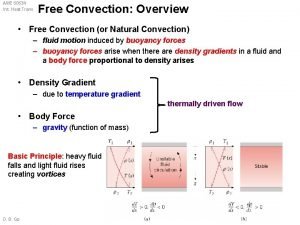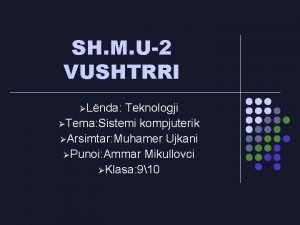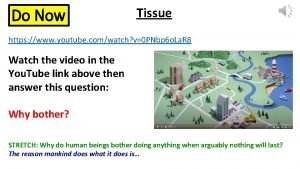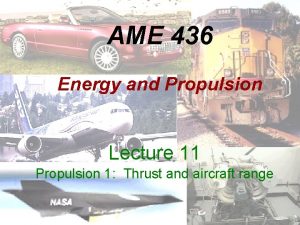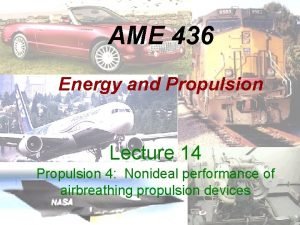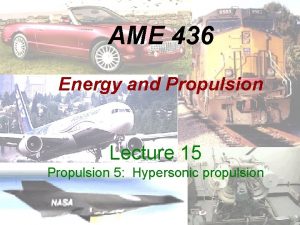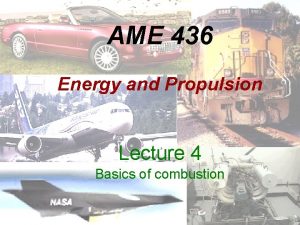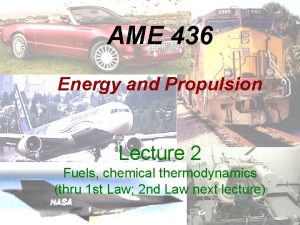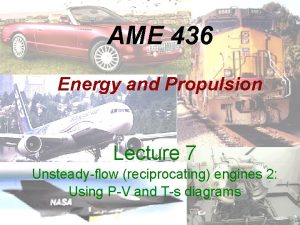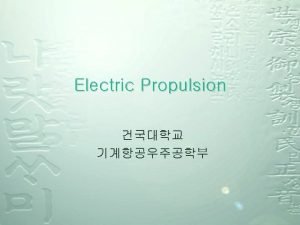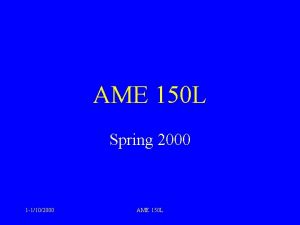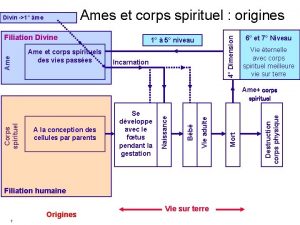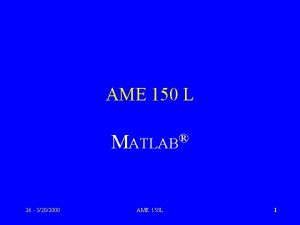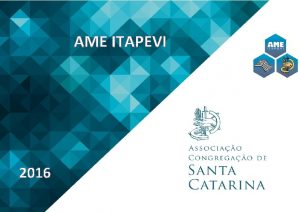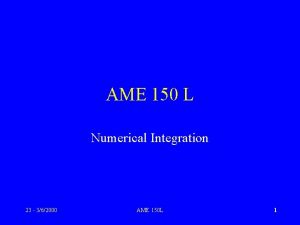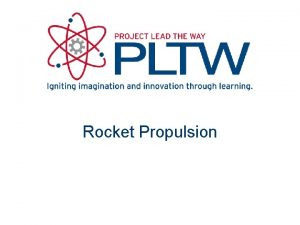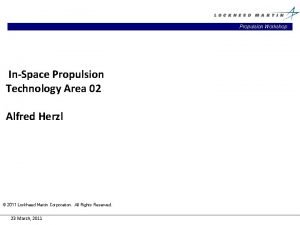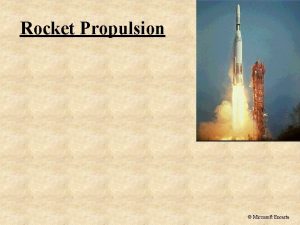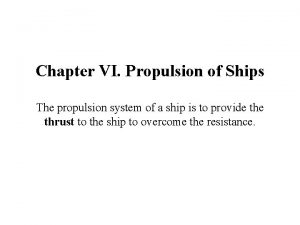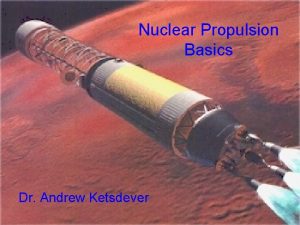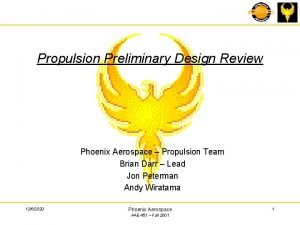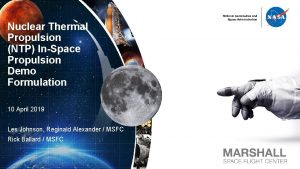AME 436 Energy and Propulsion Lecture 12 Propulsion


















































- Slides: 50

AME 436 Energy and Propulsion Lecture 12 Propulsion 2: 1 D compressible flow

Outline Ø Governing equations Ø Analysis of 1 D flows Ø Ø Isentropic, variable area Shock Constant area with friction (Fanno flow) Heat addition » Constant area (Rayleigh) » Constant P » Constant T AME 436 - Spring 2019 - Lecture 12 - 1 D Compressible Flow 2

1 D steady flow of ideal gases Ø Assumptions Ø Ø Ideal gas, steady, quasi-1 D Constant CP, Cv, CP/Cv Unless otherwise noted: adiabatic, reversible, constant area Note since 2 nd Law states d. S ≥ Q/T (= for reversible, > for irreversible), reversible + adiabatic isentropic (d. S = 0) Ø Governing equations Ø Equations of state Ø Isentropic (S 2 = S 1) (where applicable): Ø Mass conservation: Ø Momentum conservation, constant area duct (see lecture 11): » Cf = friction coefficient; C = circumference of duct » No friction: Ø Energy conservation: q = heat input per unit mass = f. QR if due to combustion w = work output per unit mass AME 436 - Spring 2019 - Lecture 12 - 1 D Compressible Flow 3

1 D steady flow of ideal gases Ø Types of analyses: everything constant except… Ø Area (isentropic nozzle flow) Ø Entropy (shock) Ø Momentum (Fanno flow) (constant area with friction) Ø Diabatic (q ≠ 0) - several possible assumptions » Constant area (Rayleigh flow) (useful if limited by space) » Constant T (useful if limited by materials) (sounds weird, heat addition at constant T…) » Constant P (useful if limited by structure) » Constant M (covered in some texts but really contrived, let's skip it) Ø Products of analyses Ø Stagnation temperature (defined later) Ø Stagnation pressure (defined later) Ø Mach number = u/c = u/( RT)1/2 (c = sound speed at local conditions in the flow (NOT at ambient condition!)) Ø From this, can get exit velocity u 9, exit pressure P 9 and thus thrust AME 436 - Spring 2019 - Lecture 12 - 1 D Compressible Flow 4

Isentropic nozzle flow Ø Reversible, adiabatic S = constant, A ≠ constant, w = 0 Ø Energy equation, q = w = 0 (momentum equation not used): Ø Define stagnation temperature Tt = temperature of gas when decelerated adiabatically to M = 0 (doesn’t need to be reversible) Ø Energy equation is just T 1 t = T 2 t: sum of thermal energy (the 1 term) and kinetic energy (the ( -1)M 2/2 term) =constant AME 436 - Spring 2019 - Lecture 12 - 1 D Compressible Flow 5

Isentropic nozzle flow Ø Pressure is related to temperature through isentropic (adiabatic + reversible) compression law: Ø Define stagnation pressure Pt = pressure of gas stream when decelerated adiabatically and reversibly to M = 0 Ø Thus the pressure / Mach number relation is simply P 1 t = P 2 t assuming reversible flow AME 436 - Spring 2019 - Lecture 12 - 1 D Compressible Flow 6

Stagnation temperature and pressure Ø Stagnation temperature Tt - measure of total energy (thermal + kinetic) of the flow Ø T = static temperature - T measured by thermometer moving with flow Ø Tt = temperature of the gas if it is decelerated adiabatically to M = 0 Ø Stagnation pressure Pt - measure of usefulness of flow (ability to expand flow) Ø P = static pressure - P measured by pressure gauge moving with flow Ø Pt = P of gas when decelerated reversibly & adiabatically to M = 0 Ø These relations are definitions of Tt & Pt at a particular state and can be used even if Tt & Pt change during the process Ø These relations assume constant & R, i. e. constant CP and M (molecular mass); what if this assumption is invalid? To be discussed in Lecture 15 AME 436 - Spring 2019 - Lecture 12 - 1 D Compressible Flow 7

Isentropic nozzle flow A/A* T/Tt P/Pt AME 436 - Spring 2019 - Lecture 12 - 1 D Compressible Flow 8

Isentropic nozzle flow Ø Relation of P & T to duct cross-section area A determined through mass conservation Ø Really messy but … AME 436 - Spring 2019 - Lecture 12 - 1 D Compressible Flow 9

Isentropic nozzle flow Ø … for adiabatic reversible flow T 1 t = T 2 t and P 1 t = P 2 t Also define throat area A* = area at M = 1 then Ø A/A* shows a minimum at M = 1, thus it is indeed a throat Ø How to use A/A* relations if neither initial state (call it 1) nor final state (call it 2) are at the throat (* condition)? AME 436 - Spring 2019 - Lecture 12 - 1 D Compressible Flow 10

Isentropic nozzle flow Ø Mass flow and velocity can be determined similarly: AME 436 - Spring 2019 - Lecture 12 - 1 D Compressible Flow 11

Isentropic nozzle flow Ø Summary A* = area at M = 1 Ø Recall assumptions: 1 D, reversible, adiabatic, ideal gas, const. Ø Implications Ø P and T decrease monotonically as M increases Ø Area is minimum at M = 1 - need a “throat” to transition from M < 1 to M > 1 or vice versa Ø is maximum at M = 1 - flow is “choked” at throat - any change in downstream conditions cannot affect Ø Note for supersonic flow, M (and u) INCREASE as area increases - this is exactly opposite subsonic flow as well as intuition (e. g. garden hose - velocity increases as area decreases) 12 AME 436 - Spring 2019 - Lecture 12 - 1 D Compressible Flow

Isentropic nozzle flow Ø When can choking occur? If M ≥ 1 or so need pressure ratio > 1. 89 for choking (if all assumptions satisfied…) Ø Where did Pt come from? Mechanical compressor (turbojet) or vehicle speed (high flight Mach number M 1) Ø Where did Tt come from? Combustion! (Even if at high M thus high Tt, no thrust unless Tt increased; otherwise just reversible compression & expansion) AME 436 - Spring 2019 - Lecture 12 - 1 D Compressible Flow 13

Stagnation temperature and pressure ØWhy are Tt and Pt so important? Recall isentropic expansion with stagnation conditions Tt and Pt to exit pressure P 9 yields ØFor exit pressure P 9 = ambient pressure P 1 and FAR << 1, ØThrust increases as Tt and Pt increase, but everything is inside square root, plus Pt is raised to small exponent - hard to make big improvements with better designs having larger Tt or Pt AME 436 - Spring 2019 - Lecture 12 - 1 D Compressible Flow 14

Stagnation temperature and pressure Ø From previous page Ø No thrust if P 1 t = P 9 t, P 9 = P 1 & T 1 t = T 9 t; to get thrust we need either A. T 9 t = T 1 t, P 9 t = P 1; P 9 < P 1 (e. g. tank of high-P, ambient-T gas) P 9 t = P 1 t P 9 < P 1 T 9 t = T 1 t P 1 = P 1 t (M 1 = 0) Case A P 9 t = P 1 t P 9 = P 1 T 9 t > T 1 t B. T 9 t > T 1 t, P 9 t = P 1 t > P 1 = P 9 P > P 1 t 1 (e. g. high-M ramjet/scramjet, (M 1 > 0) no Pt losses) Case B AME 436 - Spring 2019 - Lecture 12 - 1 D Compressible Flow 15

Stagnation temperature and pressure C. T 9 t > T 1 t, P 9 t > P 1 t = P 1 = P 9 (e. g. low-M turbojet or fan) » Fan: T 9 t/T 1 t = (P 9 t/P 1 t)( -1)/ due to adiabatic compression » Turbojet: T 9 t/T 1 t > (P 9 t/P 1 t)( -1)/ due to adiabatic compression plus heat addition » Could get thrust even with T 9 t = T 1 t, but how to pay for fan or compressor work without heat addition? ? ? P 9 t > P 1 t P 9 = P 1 T 9 t > T 1 t P 1 t = P 1 (M 1 = 0) Case C AME 436 - Spring 2019 - Lecture 12 - 1 D Compressible Flow 16

Stagnation temperature and pressure Ø Note also (Tt) ~ heat or work transfer Ø Recall (lecture 6) for control volume, steady flow q 1 2 - w 1 2 = CP(T 2 - T 1) Ø Why T not Tt in that case? KE not included in lecture 6 since KE almost always small (more specifically, M << 1) in reciprocating engines! AME 436 - Spring 2019 - Lecture 12 - 1 D Compressible Flow 17

Constant everything except S (shock) Ø Q: what if A = constant but S ≠ constant? Can anything happen while still satisfying mass, momentum, energy & equation of state? Ø A: YES! (shock) Ø Energy equation: no heat or work transfer thus Ø Mass conservation AME 436 - Spring 2019 - Lecture 12 - 1 D Compressible Flow 18

Constant everything except S (shock) Ø Momentum conservation (constant area, dx = 0) AME 436 - Spring 2019 - Lecture 12 - 1 D Compressible Flow 19

Constant everything except S (shock) Ø Complete results Ø Implications Ø M 2 = M 1 = 1 is a solution (acoustic wave, P 2 ≈ P 1) Ø If M 1 > 1 then M 2 < 1 and vice versa - equations don't show a preferred direction Ø Only M 1 > 1, M 2 < 1 results in d. S > 0, thus M 1 < 1, M 2 > 1 is impossible Ø P, T increase across shock which sounds good BUT… Ø Tt constant (no change in total enthalpy) but Pt decreases across shock (a lot if M 1 >> 1!); Ø Note there are only 2 states, ( )1 and ( )2 - no continuum of states 20 AME 436 - Spring 2019 - Lecture 12 - 1 D Compressible Flow

Constant everything except S (shock) P 2/P 1 T 2/T 1 T 2 t/T 1 t M 2 P 2 t/P 1 t AME 436 - Spring 2019 - Lecture 12 - 1 D Compressible Flow 21

Everything const. but momentum (Fanno flow) Ø Since friction loss is path dependent, need to use differential form of momentum equation (constant A by assumption) Ø Combine and integrate with differential forms of mass, energy, eqn. of state from Mach = M to reference state ( )* at M = 1 (not a throat in this case since constant area!) Ø Implications Ø Stagnation pressure always decreases towards M = 1 Ø Can't cross M = 1 with constant area with friction! Ø M = 1 corresponds to the maximum length (L*) of duct that can transmit the flow for the given inlet conditions (Pt, Tt) and duct properties (C/A, Cf) Ø Note C/A = Circumference/Area = 4/diameter for round duct AME 436 - Spring 2019 - Lecture 12 - 1 D Compressible Flow 22

Everything const. but momentum (Fanno flow) Ø What if neither the initial state (1) nor final state (2) is the choked (*) state? Again use P 2/P 1 = (P 2/P*)/(P 1/P*) etc. , except for L, where we subtract to get net length L AME 436 - Spring 2019 - Lecture 12 - 1 D Compressible Flow 23

Everything constant but momentum Pt/Pt* Tt/Tt* T/T* Length P/P* Length AME 436 - Spring 2019 - Lecture 12 - 1 D Compressible Flow 24

Everything constant but momentum Pt/Pt* P/P* Tt/Tt* T/T* Length AME 436 - Spring 2019 - Lecture 12 - 1 D Compressible Flow 25

Heat addition at const. Area (Rayleigh flow) Ø Mass, momentum, energy, equation of state all apply Ø Reference state ( )*: use M = 1 (not a throat in this case!) Ø Energy equation not useful except to calculate heat input (q = Cp(T 2 t - T 1 t)) Ø Implications Ø Stagnation temperature always increases towards M = 1 Ø Stagnation pressure always decreases towards M = 1 (stagnation temperature increasing, more heat addition) Ø Can't cross M = 1 with constant area heat addition! Ø M = 1 corresponds to the maximum possible heat addition Ø …but there's no particular reason we have to keep area (A) constant 26 when we add heat! AME 436 - Spring 2019 - Lecture 12 - 1 D Compressible Flow

Heat addition at const. Area (Rayleigh flow) Ø What if neither the initial state (1) nor final state (2) is the choked (*) state? Again use P 2/P 1 = (P 2/P*)/(P 1/P*) etc. AME 436 - Spring 2019 - Lecture 12 - 1 D Compressible Flow 27

Heat addition at constant area Pt/Pt* Tt/Tt* P/P* T/T* AME 436 - Spring 2019 - Lecture 12 - 1 D Compressible Flow 28

T-s diagram - reference state M = 1 Fanno M < 1 Shock Rayleigh M < 1 M > 1 AME 436 - Spring 2019 - Lecture 12 - 1 D Compressible Flow 29

T-s diagram - Fanno, Rayleigh, shock Rayleigh Constant area, with friction, no heat addition Shock M < 1 Constant area, no friction, with heat addition Fanno M < 1 M > 1 This jump: constant area, no friction, no heat addition SHOCK! AME 436 - Spring 2019 - Lecture 12 - 1 D Compressible Flow 30

Heat addition at constant pressure Ø Relevant for hypersonic propulsion if maximum allowable pressure (i. e. structural limitation) is the reason we can't decelerate the ambient air to M = 0) Ø Momentum equation: Ad. P + du = 0 u = constant Ø Reference state ( )*: use M = 1 again but nothing special happens there Ø Again energy equation not useful except to calculate q Ø Implications Ø Stagnation temperature increases as M decreases, i. e. heat addition corresponds to decreasing M Ø Stagnation pressure decreases as M decreases, i. e. heat addition decreases stagnation P Ø Area increases as M decreases, i. e. as heat is added AME 436 - Spring 2019 - Lecture 12 - 1 D Compressible Flow 31

Heat addition at constant pressure Ø What if neither the initial state (1) nor final state (2) is the reference (*) state? Again use P 2/P 1 = (P 2/P*)/(P 1/P*) etc. AME 436 - Spring 2019 - Lecture 12 - 1 D Compressible Flow 32

Heat addition at constant P Pt/Pt* P/P* Tt/Tt* T/T*, A/A* AME 436 - Spring 2019 - Lecture 12 - 1 D Compressible Flow 33

Heat addition at constant temperature Ø Probably most appropriate case for hypersonic propulsion since temperature (materials) limits is usually the reason we can't decelerate the ambient air to M = 0 Ø T = constant a (sound speed) = constant Ø Momentum: Ad. P + du = 0 d. P/P + Md. M = 0 Ø Reference state ( )*: use M = 1 again Ø Implications Ø Stagnation temperature increases as M increases Ø Stagnation pressure decreases as M increases, i. e. heat addition decreases stagnation P Ø Minimum area (i. e. throat) at M = -1/2 Ø Large area ratios needed due to exp[ ] term AME 436 - Spring 2019 - Lecture 12 - 1 D Compressible Flow 34

Heat addition at constant temperature Ø What if neither the initial state (1) nor final state (2) is the reference (*) state? Again use P 2/P 1 = (P 2/P*)/(P 1/P*) etc. AME 436 - Spring 2019 - Lecture 12 - 1 D Compressible Flow 35

Heat addition at constant T Tt/Tt* A/A* T/T* Pt/Pt* P/P* AME 436 - Spring 2019 - Lecture 12 - 1 D Compressible Flow 36

T-s diagram for diabatic flows Const P Const T Rayleigh (Const A) AME 436 - Spring 2019 - Lecture 12 - 1 D Compressible Flow 37

T-s diagram for diabatic flows Rayleigh (Const A) Const P Const T AME 436 - Spring 2019 - Lecture 12 - 1 D Compressible Flow 38

Area ratios for diabatic flows Const T Const P Const A AME 436 - Spring 2019 - Lecture 12 - 1 D Compressible Flow 39

What is the best way to add heat? Ø If maximum T or P is limitation, obviously use that case Ø What case gives least Pt loss for given increase in Tt? Ø Minimize d(Pt)/d(Tt) subject to mass, momentum, energy conservation, eqn. of state Ø Result (lots of algebra - many trees died to bring you this result) Ø Adding heat (increasing Tt) always decreases Pt Ø Least decrease in Pt occurs at lowest possible M – doesn’t really matter if it's at constant A, P, T, etc. AME 436 - Spring 2019 - Lecture 12 - 1 D Compressible Flow 40

Summary - 1 D compressible flow Const. A? Adiabatic? Frictionless? Tt const. ? Pt const. ? Isentropic No Yes Yes Fanno Yes No Shock Yes Yes No Rayleigh Yes No No Const. T heat addition No No Yes No No Const. P heat addition No No Yes No No AME 436 - Spring 2019 - Lecture 12 - 1 D Compressible Flow 41

Summary of heat addition processes Const. A Const. P Const. T M Goes to M = 1 Decreases Increases Area Constant Increases Min. at M = -1/2 P Decreases for M < 1 Increases for M > 1 Constant Decreases Pt Decreases T Increases except for a small region at M < 1 Increases Constant Tt Increases AME 436 - Spring 2019 - Lecture 12 - 1 D Compressible Flow 42

Example #1 Helium ( = 5/3, molecular mass 4 g/mole) is used in a simple propulsion system. It is heated to T = 1500 K, P = 10 atm and Mach number 0. 3 (T and P are the static temperature and pressure, that is, not Tt and Pt), then expanded isentropically through a nozzle to P = 2 atm. (1 atm = 101325 N/m 2). a) Compute the stagnation temperature Tt and stagnation pressure Pt. b) Compute the exit velocity of the gases after expansion. c) Compute the ratio of exit area to nozzle throat area (A/A*). First we need to compute the exit Mach number M 9: AME 436 - Spring 2019 - Lecture 12 - 1 D Compressible Flow 43

Example #1 d) Compute the Specific Thrust if the ambient pressure and temperature are 1 atm and 300 K. Note that u 1 = 0 and FAR = 0 in this case (i. e. this is effectively a rocket motor not an airbreathing propulsion device) and that the exit pressure does not equal ambient pressure. First we need to compute the exit temperature T 9: Then using the thrust equation for P 9 ≠ P 1 (Lecture 11, page 16): Note that this is the Specific Thrust based on the sound speed at ambient conditions (300 K). If you chose to calculate Specific Thrust using the sound speed at condition 1 (1500 K) that’s OK too. For airbreathing propulsion systems state 1 is the ambient condition but in this case since there’s no inlet one needs to specify the reference condition. 44 AME 436 - Spring 2019 - Lecture 12 - 1 D Compressible Flow

Example #2 Consider a very simple propulsion system operating at a flight Mach number of 5 that consists of 2 processes: Process 1: Shock at entrance to duct Process 2: Heat addition in a constant-area duct until thermal choking occurs a) Compute all of the following properties of this system: (i) Static (not stagnation) temperature relative to T 1 after the shock (ii) Static (not stagnation) pressure relative to P 1 after the shock AME 436 - Spring 2019 - Lecture 12 - 1 D Compressible Flow 45

Example #2 exit (iii) Static (not stagnation) temperature and pressure relative to T 1 at the (iv) Dimensionless heat addition {qin/RT 1 = CP(T 3 t-T 2 t)/RT 1 = [ /( ‑ 1)](T 3 t-T 2 t)/T 1} AME 436 - Spring 2019 - Lecture 12 - 1 D Compressible Flow 46

Example #2 (v) Specific thrust (assume FAR << 1 in the thrust calculation) (vi) Overall efficiency (vii) Draw this cycle on a T - s diagram. Include appropriate Rayleigh and Fanno curves. AME 436 - Spring 2019 - Lecture 12 - 1 D Compressible Flow 47

Example #2 b) Repeat (a) if a nozzle is added after station 3 to expand the flow isentropically back to P = P 1. Everything is the same up to state 3, but now we have a state 4, i. e. isentropic expansion (P 4 t = P 3 t, T 4 t = T 3 t until P 4 = P 1. Heat addition is the same as before, so AME 436 - Spring 2019 - Lecture 12 - 1 D Compressible Flow 48

Example #2 c) Why was thrust generated in part (b) but not part (a)? In part (a) there is no area change and no friction, so there is no mechanism for the gas pressure to exert a force in the x-direction on the walls of the combustion device, so there is no way to generate thrust (net force in the xdirection). In part (b) a nozzle was added, so the area changes, so some part of the wall is not oriented parallel to the x-direction, so the gas pressure can exert a force in the x-direction on the walls of the combustion device and thus generate thrust. AME 436 - Spring 2019 - Lecture 12 - 1 D Compressible Flow 49

Summary - compressible flow Ø The 1 D conservation equations for energy, mass and momentum along with the ideal gas equations of state yield a number of unusual phenomenon Ø Choking - isentropic, diabatic (Rayleigh), friction (Fanno), all at M = 1; for heat addition at constant T, choking at M = 1/ 1/2 Ø Garden hose in reverse (rule of thumb: for supersonic flow, all of your intuitions about flow should be reversed) Ø If no friction, no heat addition, no area change - it's a shock! Ø Stagnation conditions Ø Temperature - a measure of the total energy (thermal + kinetic) contained by a flow Ø Pressure - a measure of the “usefulness” (ability to expand) of a flow AME 436 - Spring 2019 - Lecture 12 - 1 D Compressible Flow 50
 Csce 436
Csce 436 Csce 436
Csce 436 Csce 436
Csce 436 Physical science 436
Physical science 436 01:640:244 lecture notes - lecture 15: plat, idah, farad
01:640:244 lecture notes - lecture 15: plat, idah, farad Energy energy transfer and general energy analysis
Energy energy transfer and general energy analysis Energy energy transfer and general energy analysis
Energy energy transfer and general energy analysis Inertial propulsion drive
Inertial propulsion drive Propulsión en el sistema digestivo
Propulsión en el sistema digestivo Bilaminaire
Bilaminaire Jet engine diffuser
Jet engine diffuser L-3 combat propulsion systems
L-3 combat propulsion systems Propulsion efficiency
Propulsion efficiency Stern landing vessel
Stern landing vessel Magnetic space propulsion
Magnetic space propulsion Nuclear propulsion officer candidate program
Nuclear propulsion officer candidate program Spacex starting salary
Spacex starting salary Siva de scalzo
Siva de scalzo Nuclear propulsion
Nuclear propulsion Andrew ketsdever
Andrew ketsdever Nuclear thermal propulsion
Nuclear thermal propulsion Squid use jet propulsion for rapid escapes
Squid use jet propulsion for rapid escapes Utilities and energy lecture
Utilities and energy lecture Ame church decalogue
Ame church decalogue Que tes vives eaux accords
Que tes vives eaux accords Que rien ne te trouble que rien ne t'effraie
Que rien ne te trouble que rien ne t'effraie Petrit ame
Petrit ame Ame 20217
Ame 20217 Tarde te ame san agustin dibujos
Tarde te ame san agustin dibujos Pllaka ame
Pllaka ame Pllaka ame
Pllaka ame Ame
Ame Qka eshte pllaka ame
Qka eshte pllaka ame Ame 445
Ame 445 Mon ame est attache a toi
Mon ame est attache a toi Usc ame
Usc ame Je me tiens à la porte et je frappe partition
Je me tiens à la porte et je frappe partition Ame bibapi
Ame bibapi Isme passerelle
Isme passerelle Cuando me ame de verdad
Cuando me ame de verdad Trans ame
Trans ame Trans ame
Trans ame A mia mi piace a nutella
A mia mi piace a nutella Pllakat per zgjerim
Pllakat per zgjerim Amé la justicia y odié la iniquidad
Amé la justicia y odié la iniquidad Quando me amei de verdade charles chaplin
Quando me amei de verdade charles chaplin Victor hugo desejo
Victor hugo desejo @cottonswoob:https://youtu.be/n1fv2d2nv64
@cottonswoob:https://youtu.be/n1fv2d2nv64 Desejo poema victor hugo
Desejo poema victor hugo Mon âme se repose en paix sur dieu seul
Mon âme se repose en paix sur dieu seul Percibi que mi mente puede atormentarme
Percibi que mi mente puede atormentarme
